A Simple Guide to Help Understand
Buddhist Monks
Jump Station
[Introduction]
[The Guiding Rules of Buddhism - The Five, Eight and Ten Precepts]
[Role of Laity and Monks in the Monastic Life] [Monks - Ordination]
[Dress] [Monastic Practices] [Nirvana]
[Is Buddha a Man or God?]
[If Buddha is Not a God, Why Do People Worship Him?]
Introduction: I have attempted to summarize a great deal of information and put it into an understanding format. I may have left out some important information which is significant but I didn't feel it added anything to what I was trying to portray or it may have made the information more complex and confusing. For this I apologize because I don't want the information to be misleading. If you want to see the original source of my information just click on any of the links listed. I have found that a Google search of any term to have been most rewarding.
All Buddhists are suppose to observe the Five Precepts. Unlike the Ten Commandments these are only recommendations on how to live a good life. Lay people who live in the Monastery must abide by the traditional Five Buddhist precepts.
The first Five Precepts focus on avoiding morally bad behavior:
The Eight Precepts are rules for lay people who live in the Monastery and lay men and women who wish to practice a bit more strictly than the usual five precepts for Buddhists. The eight precepts focus both on avoiding morally bad behavior, and on leading a more ascetic lifestyle.
Monks who live in the monastery must observe The Ten Precepts:
Traditionally, Theravada Buddhism(the form of Buddhism practiced in Thailand) has observed a distinction between the practices suitable for a lay person and the practices undertaken by ordained monks (in ancient times, there was a separate body of practices for nuns).
The role of lay people has traditionally been primarily occupied with activities that are commonly termed merit making. Merit making activities include offering food and other basic necessities to monks, making donations to temples and monasteries, burning incense or lighting candles before images of the Buddha, and chanting protective or merit-making verses from a standard collection of scriptures in the Theravada Buddhist tradition, as preserved in the Pali language and thus called the Pali Canon. It is the only completely surviving early Buddhist canon, and one of the first to be written down.
Some lay practitioners have always chosen to take a more active role in religious affairs, while still maintaining their lay status. Dedicated lay men and women sometimes act as trustees or custodians for their temples, taking part in the financial planning and management of the temple. Others may volunteer significant time in tending to the mundane needs of local monks (by cooking, cleaning, maintaining temple facilities, etc.). Lay activities have traditionally not extended to study of the Pali scriptures, nor the practice of meditation, though in the 20th Century these areas have become more accessible to the lay community, especially in Thailand.
One of the duties of the lay followers, as taught by the Buddha, is to look after the needs of the monk/nuns. They are to see that the monk/nuns do not suffer from lack of the four requisites: food, clothing, shelter and medicine. As neither monks nor nuns are allowed to have an occupation, they depend entirely on the laity for their sustenance. In return for this charity, they are expected to lead exemplary lives.
The Five, Eight and Ten Precepts
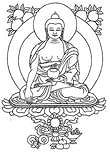
![]()
Buddhist Monks
Role of Laity and Monks in the Monastic Life

![]()
Lay Devotee
Role of Lay People

![]()
Monks
Ordination
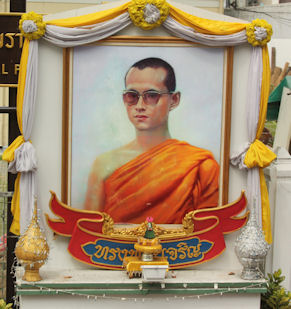
Rama IX, King of Thailand
when he served as a Monk
| The minimum age for ordaining as a Buddhist monk is 20 years, reckoned from conception. However, boys under that age are allowed to ordain as novices (samanera), performing a ceremony such as Shinbyu a Burmese term for a novitiation ceremony in the tradition of Theravada Buddhism It is deemed the most important duty that parents owe to their son by letting him go forth and embrace the legacy of the Buddha, join the Sangha and become immersed in the teachings of the Buddha, the Dhamma, at least for a short while, perhaps longer if not for the rest of his life. Shinbyu may well be regarded as a rite of passage or coming of age ceremony as in other religions. Spending some time however short it may be, in a Buddhist Vihara (Monastery) in his youthful days is regarded by most Buddhists as the best religious inheritance to children by the parents and it will have a lasting effect on his life. | 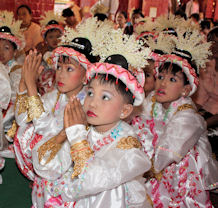
Boys going through Shinbyu at Monastery in Mandalay, Myanmar |
| Novices shave their heads, wear the yellow robes, and observe ten basic precepts. Although no specific minimum age for novices is mentioned in the scriptures, traditionally boys as young as seven are accepted. This tradition follows the story of the Lord Buddha's son, Rahula, who was allowed to become a novice at the age of seven. Monks follow 227 rules of discipline, while nuns follow 311 rules. Monks regularly leave the robes after acquiring an education. | 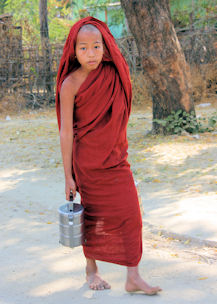
Young boys often become monks while they attend school in a monastery |
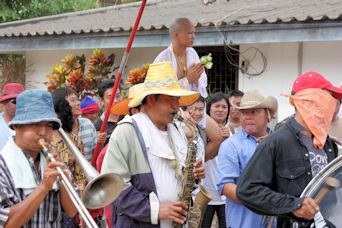
The whole village celebrates when a young man joins the monastery for his ordination. |
In most Theravada countries, it is a common practice for young men to ordain as monks for a fixed period of time. Even Rama IX, the current King of Thailand, spent time as an ordained monk. The tradition is very strong. In Thailand and Burma, young men typically are ordained for the 3 month Rain Retreat "Vassa", though shorter or longer periods of ordination are not rare. Traditionally, temporary ordination was even more flexible among Laotians. Once they had undergone their initial ordination as young men, Laotian men were permitted to temporarily ordain again at any time, though married men were expected to seek their wife's permission. Throughout Southeast Asia, there is little stigma attached to leaving the monastic life. A monk may leave the monastery when when compelled by family obligations or ill health - or maybe to become King Rama IX. |
Ordaining as a monk, even for a short period, is seen as having many virtues. In many Southeast Asian cultures, it is seen as a means for a young man to "repay" his parents for their work and effort in raising him, because the merit from his ordination accrues to them as well. Thai men who have ordained as a monk may be seen as more fit husbands by Thai women, who refer to men who have served as monks with a colloquial term meaning "cooked" to indicate that they are more mature and ready for marriage. Particularly in rural areas, temporary ordination of boys and young men traditionally gave peasant boys an opportunity to gain an education in temple schools without committing to a permanent monastic life.
| The Buddha is nearly always depicted wearing a monastic robe, of the type worn by Buddhist monks today. The robe basically consists of a long skirt which goes from the waist to the ankles and a long robe which can be draped over the upper and lower body. The larger robe may be shown as worn in the "covering mode" (draped over both shoulders) or in the "open mode" (leaving the right shoulder and breast uncovered). The robe is a representation of the Buddha's humility. (Gautama was originally a prince, who renounced the world to seek enlightenment, and his original robe was made from the shroud of a corpse.) The robe is sometimes shown as transparent or billowing mysteriously suggesting the spiritual power emanating from the Buddha. Buddha images are often draped with real robes, which are renewed periodically, usually at major festivals. The Buddha may also be shown wearing royal attire, but this is uncommon. | 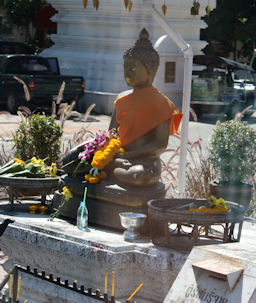 Statues of Buddha are frequently covered with robes |
The practices usually vary in different sub-schools and monasteries within Theravada. But in the most orthodox forest monastery, the monk usually models his practice and lifestyle on that of the Buddha and his first generation of disciples by living close to nature in forest, mountains and caves. Forest monasteries still keep alive the ancient traditions through following the Buddhist monastic code of discipline in all its detail and developing meditation in secluded forests.

![]()
Monastic Practices
| In a typical daily routine at the monastery during the 3 month Rain Retreat "Vassa", the monk will wake up before dawn and will begin the day with group chanting and meditation. At dawn the monks will go out to surrounding villages bare-footed on alms-round and will have the first meal of the day by eating from the bowl by hand. After the alms are given the people kneel and the monk gives the following blessing:
The merit which you have done. May you be free from enmity and danger. May you be free from mental suffering. May you be free from physical suffering. And may you take care of yourself happily. May your parent, relative, friends, and every living being be happy. Love and Peace be with you. |
 Before dawn the monks go out to collect alms which are freely given by local citizens. No begging is permitted, all donations must be freely given. |
Most of the day is spent on studying the truth taught by Buddha (Dhamma) and meditation. Sometimes the abbot or a senior monk will give a Dhamma(the truth taught by Buddha) talk to the visitors.
Buddhist novice monks and novice nuns living in the monastery must practice the Ten Precepts set forth above.
Scholar monks undertake the path of studying and preserving the Pali literature of the Theravada. They may devote little time to the practice of meditation, but may attain great respect and renown by becoming masters of a particular section of the Pali Canon or its commentaries.
Meditation monks: After the end of the Vassa period, many of the monks will go out far away from the monastery to find a remote place (usually in the forest)where they can hang their umbrella tents and where it is suitable for the work of self-development. When they go wandering, they walk barefoot, and go wherever they feel inclined. Only those requisites which are necessary will be carried along. These generally consist of the bowl, the three robes, a bathing cloth, an umbrella tent, a mosquito net, a kettle of water, a water filter, razor, sandals, some small candles, and a candle lantern.
Meditation Monks are often called forest monks because of their association with certain wilderness-dwelling traditions, are considered to be specialists in meditation. While some forest monks may undertake significant study of the Pali Canon, in general meditation monks are expected to learn primarily from their meditation experiences and personal teachers, and may not know more of the Tipitaka than is necessary to participate in liturgical life and to provide a foundation for fundamental Buddhist teachings. More so than the scholastic tradition, the meditation tradition is associated with the attainment of certain supernatural powers described in both Pali sources and folk tradition. These powers include the attainment of Nirvana, mind-reading, supernatural power over material objects and their own material bodies, seeing and conversing with gods and beings living in hell, and remembering their past lives. These powers are called abhiñña. Sometimes the remains of the cremated bone fragment of an accomplished forest monk, it is believed. is able to transfom itself into crystal-like relics.
The monks do not fix their times for walking and sitting meditation, for as soon as they are free they just start doing it; nor do they determine for how long they will go on to meditate. Some of them sometimes walk from dusk to dawn whereas at other times they may walk from between two to seven hours. Some may decide to fast for days or stay at dangerous places where ferocious animals live in order to aid their meditation.
Those monks who have been able to achieve a high level of attainment will be able to guide the junior monks and lay Buddhists toward the four degrees of spiritual attainment.
Traditionally, a ranking monk will deliver a sermon four times a month: when the moon waxes and wanes and the day before the new and full moons. The laity also have a chance to learn meditation from the monks during these times.
It is also possible for a lay disciple to become enlightened. As Bhikkhu Bodhi notes, "The Suttas and commentaries do record a few cases of lay disciples attaining the final goal of Nirvana. However, such disciples either attain Arahantship on the brink of death or enter the monastic order soon after their attainment. They do not continue to dwell at home because dwelling at home is incompatible with the state of one who has severed all craving."
Nirvana, the highest goal of Theravada Buddhism, means to bring an end to the vicious cycle of birth, life, death, and rebirth. It is attained through study and the practice of morality, meditation and wisdom. The goal of Nirvana (and its associated techniques) have traditionally been seen as the domain of the fully ordained monastic, whereas many of the same techniques can be used by laypeople to generate happiness in their lives, without focusing on Nirvana. Monastic roles in the Theravada can be broadly described as being split between the role of the (often urban) scholar monk and the (often rural or forest) meditation monk. Both types of monks serve their communities as spiritual teachers and officiants by presiding over spiritual ceremonies and providing instruction in basic Buddhist morality and teachings.
The commonly accepted definition of the term "God" is of a being who rules and created the universe. The Buddha of the early texts gives arguments refuting the existence of such a being.

![]()
Nirvana
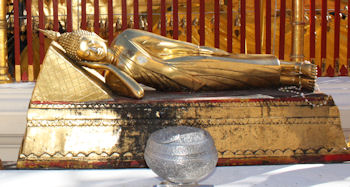
The Buddha achieved Nirvana
right before his death
![]()
Is The Buddha Man or God
| Statements from modern Theravadins that the Buddha was "just a human" are often intended to contrast their view of him with those of the original teachings of the Buddha in the Mahayana sutras, and with Christian views of Jesus. According to the Canon, Gotama was born as a human, albeit highly spiritually developed as a result of the previous lives in the career of the bodhisatta. With his enlightenment, however, he perfected and transcended his human condition. When asked whether he was a god or a human, he replied that he had eliminated the deep-rooted unconscious traits that would make him either one, and should instead be called a Buddha; one who had grown up in the world but had now gone beyond it, as a lotus grows from the water but blossoms above it, unsoiled. | 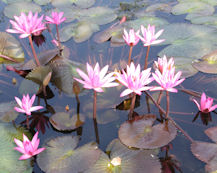 |
Buddhism itself generally ignores the question regarding the origin of life. The Buddha regarding the origin of life has said "Conjecture about [the origin of]the world . . . would bring madness & vexation to anyone who conjectured about it." The Buddha also compared the question of the origin of life - as well as many other metaphysical questions - to the parable of the poison arrow: a man is shot with a poison arrow, but before the doctor pulls it out, he wants to know who shot it (arguing the existence of God), where the arrow came from (where the universe and/or God came from) why that person shot it (why God created the universe), etc. If the doctor keeps asking these questions before the arrow is pulled out, the Buddha reasoned, the patient will die before he gets the answers. Buddhism is less concerned with answering questions like the origin of life, and more concerned with the goal of saving oneself and other beings from suffering by attaining Nirvana (Enlightenment).
Modern day Buddhists, such as the Dalai Lama, don't perceive a conflict between Buddhism and science and consider they are complementary means of understanding the world around us.
There are different types of worship. When someone worships a god, they praise him or her, making offerings and ask for favours, believing that the god will hear their praise, receive their offerings and answer their prayers. Buddhists do not indulge in this kind of worship.
The other kind of worship is when we show respect to someone or something we admire. When a teacher walks into a room we stand up, when we meet a dignitary we shake hands,when the national anthem is played we salute. These are all gestures of respect and worship and indicate our admiration for persons and things.
We must always be aware of and respect cultural differences. In Hinduism their gods are refered to as "Lords". There is the "Trinity" of Lord Brahma, Lord Shiva and Lord Vishnu and the beloved Lord Ganesha and
Lord Hanuman

![]()
If The Buddha Is Not A God, Then Why Do People Worship Him?
| This is the type of worship Buddhist practise. A statue of the Buddha with its hands rested gently in its lap and its compassionate smile reminds us to strive to develop peace and love within ourselves. The perfume of incense reminds us of the pervading influence of virtue, the lamp reminds us of light of knowledge and the flowers which soon fade and die, reminds us of impermanence. When we bow, we express our gratitude to the Buddha for what his teachings have given us. This is the nature of Buddhist worship. |  |

(Editor's note, 27 April 2010: This page is now being construction so come back again.
If you have any insights - constructive comments - you wish to share please do so.)
![]()
![]()
For more information about our travels write to![]() Belli.
Belli.